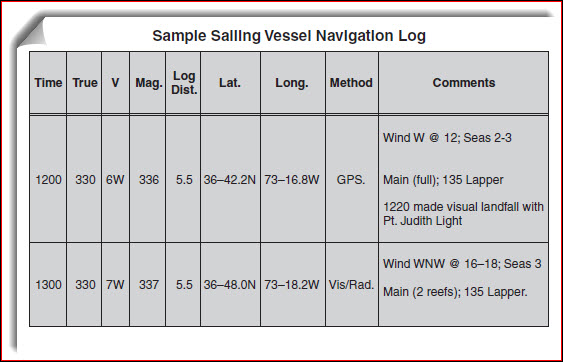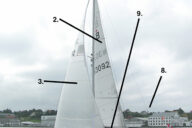Thanks to Capt. John of skippertips.com… for his insight on boat logs.
Did you know that all of sailing navigation starts with one vital legal document. And it’s not your boat registration or documentation. Nope, not by a long shot. Sail without this and you could place your boat and crew at high risk in a legal case or even be unable to prove your “right action” in a court of law. Read on to discover one of the most overlooked aspects of recreational sailing or boating!
We had caught them stealing red-handed, and now had them under arrest. It was a cold January day at sea. Throughout the night we had followed the huge fishing trawler as she sneaked into the waters of the delicate US Continental Shelf. Her goal was to fish for lobster–and that’s just what she was doing in the middle of the night! Against the law? You bet! And we had her in our grasp. Our boarding party was aboard, her captain confined to quarters, and our boarding crew had taken over the ship. We were escorting her into the port of New York, where her captain and crew would be formally arrested. After we moored, our Captain called me into his cabin. “We need every chart, log, and document kept throughout the incident” he said. So, my crew and I gathered all together and went to see the prosecuting attorney. Sure enough, those logs and charts were vital, legal documents that would make or break this case. And break it they did! The ship was seized, the captain and crew repatriated to their country in disgrace, and the Coast Guard credited with another bust of the bad guys…

Make your Boat log simple, clear, and legible. Use a single horizontal line for mistakes and initial the entry. Imagine that you hand your boat log to someone unfamiliar with sailing. Could he or she read and understand it? Make each entry in your log with this single point in mind. (illustration from “Seamanship Secrets”).
As you can see from this actual sea story, your boat logs play an important role as a legal document. Keep your logs neat, concise, and use proper entry procedures. And that includes log entry corrections too (more on this later).
Make log entries clear and simple. Set your boat log up so that it reads like a story (see the sample entries above). That way, if someone else picks up your boat log, they will be able to read across the columns and interpret all events from start to finish. Follow these five basic rules of thumb:
1. Make Entries Each Hour
Skippers make the call when it comes to log entry frequency. But it’s best to keep consistent log keeping–and that means once each hour. This gives you more historical data for weather, engineering, and navigation.
Compare this to a graph. The more points plotted onto the graph within a smaller time frame, the smoother and more complete the historical picture. Make more frequent log entries for an easier-to-understand story of your boat’s history.
2. Separate Navigation from Engineering
Consider separate log books or log book sections to segregate navigation entries and engineering related entries. Note in the illustrations how the navigation entries can include weather because wind and sea direction have a direct impact on the available sailing course. Engineering entries should include engine, water and fuel capacity, battery voltage, fluid pressures (oil; transmission fluid) and holding tank level (if available).
3. Correct Mistakes the Correct Way
Most crew have no idea how to make proper log corrections. Ban scribbles from your logs. You can bet that more than one log error has been blacked out with multiple line-outs or even correction tape or whiteout. Major mistake! Don’t even think about it. There’s one way and one way alone to correct a legal entry in a boat or ship log. One line; initials; correction above or adjacent to the error.
Use a single horizontal line and initial the correction near the entry. That way, the correction can still be read and you can address any questions to the person who made the correction. If you need to prove a case in a collision or grounding or liability issue, do this. It’s that important. Train your sailing crew or partner the right way before they assume the watch underway.
4. Log Times for Underway, Anchoring, Mooring, and Landfall
Start your log with the time that you cast off. For example: “0930 Underway from Newport Yacht Club, Rhode Island enroute St. Maarten, Caribbean”. Log similar entries when you anchor or moor inside a harbor.
Make landfall a key entry in your boat log. Write down the time of landfall, how it was sighted (visually, by radar), and specify the name of the lighthouse, island, or point of land. You might also add comments such as relative direction of sighting (dead ahead; off the port bow; off the starboard bow) and current weather conditions.
5. Protect Your Log Book for the Future
Keep your boat log in a safe area where you can access it in a moment’s notice. In an emergency, your log needs to go with you, along with your “ditch kit”. Once you fill up your logbook, put it into a plastic, waterproof bag to protect it from mold, mildew, or water damage. When you leave the boat for extended periods, carry your logbook with you.
~~~~~~~~~~~~~~~~~~~~
Follow these five simple sailing navigation rules of log keeping on your small cruising sailboat. Gain the peace-of-mind that comes when you keep this vital document up to date–wherever in the world you choose to cruise!












